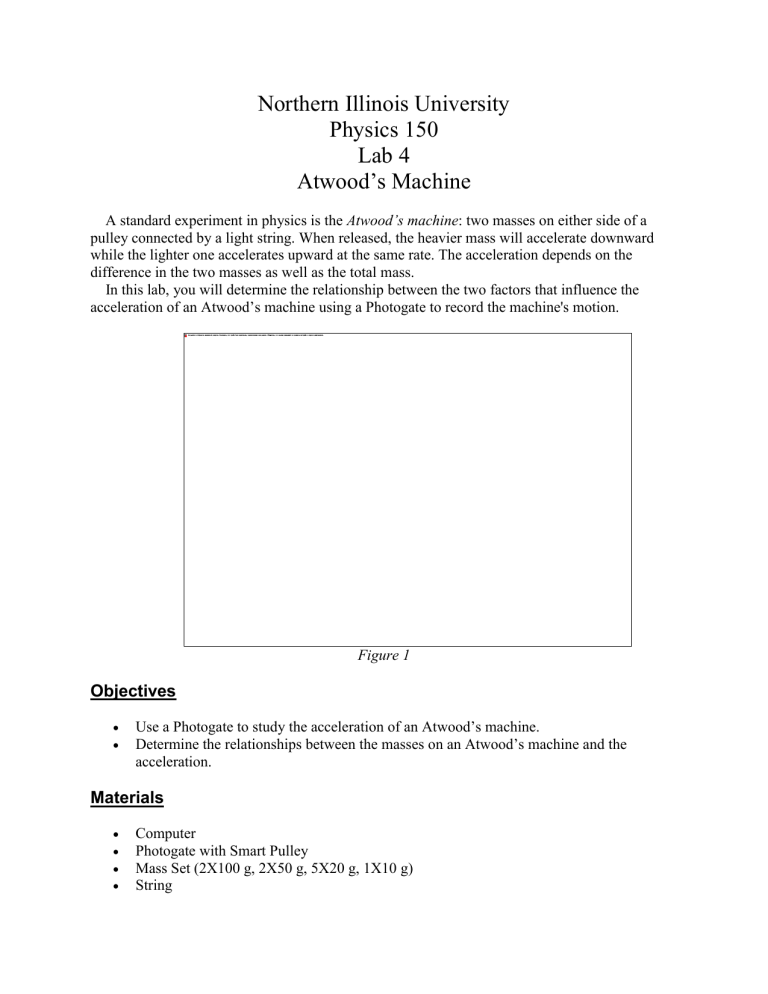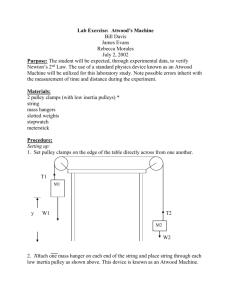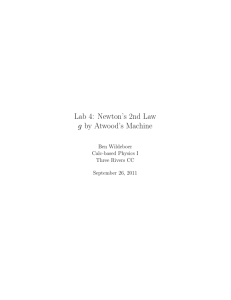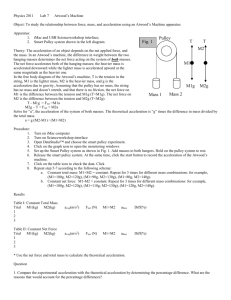Lab 4 - Atwood's Machine - Northern Illinois University

Northern Illinois University
Physics 150
Lab 4
Atwood’s Machine
A standard experiment in physics is the
Atwood’s machine
: two masses on either side of a pulley connected by a light string. When released, the heavier mass will accelerate downward while the lighter one accelerates upward at the same rate. The acceleration depends on the difference in the two masses as well as the total mass.
In this lab, you will determine the relationship between the two factors that influence the acceleration of an Atwood’s machine using a Photogate to record the machine's motion.
Figure 1
Objectives
Use a Photogate to study the acceleration of an Atwood’s machine.
Determine the relationships between the masses on an Atwood’s machine and the acceleration.
Materials
Computer
Photogate with Smart Pulley
Mass Set (2X100 g, 2X50 g, 5X20 g, 1X10 g)
String
Ringstand
Procedure
Part 1: Constant Total Mass
For this part of the experiment you will keep the total mass used constant, but move weights from one side to the other.
1. Set up the Atwood’s machine apparatus as shown in Figure 1. Be sure that the masses can move at least 40 cm before the heavier mass strikes the floor.
2. Connect the Photogate to the LabPro interface.
3. Turn on the computer and start Logger Pro. In the File Open menu, select Physics with
Vernier, then #10 Atwoods Machine.
4. The computer should detect the photogate.
5. Arrange on your Atwood’s machine a collection of masses totaling 210 g for m
1 and
190 g for m
2
.
6. To measure the acceleration of this system, pull the smaller mass down about 40 cm.
Start data collection. Steady the masses so they are not swinging. Then release the smaller mass, catching the falling mass before it strikes the floor or the other mass strikes the pulley.
7. Select “analyze data”; a linear fit will give you the acceleration in m/s 2 .
8. Move 10 g from m
2
to m
1
. Record the new masses in the Data Table.
11. Repeat Steps 6 – 7 to determine the acceleration of this new mass combination, recording the values in the Data Table.
12. Continue to move masses from m
2
to m
1
in 5-g increments, changing the difference between the masses, but keeping the total constant. Repeat Steps 6 – 7 for each mass combination. Continue until you collect data for at least five different mass combinations.
Part 2: Constant Mass Difference
For this part of the experiment you will keep the difference in mass between the two sides of the Atwood’s machine constant and increase the total mass.
13. Use 120 g for m
1
and 100 g for m
2
.
14. As you did before, collect data and determine the acceleration.
15. Add mass in 20-g increments to both sides, keeping a constant difference of 20 grams. Record the resulting mass for each combination in the Data Table. Collect motion data and determine the acceleration for at least five different mass combinations.
Data Tables
Trial
3
4
1
2
5
3
4
1
2
5
Trial m
1
(g)
210 m
1
(g)
120
Part 1: Constant Total Mass m
2
(g)
190
Acceleration
(m/s2)
Part 2: Constant Mass Difference m
2
(g)
100
Acceleration
(m/s2)
m
(g)
m
(g) m
T
(g) m
T
(g)
Discussion
1.
For each trial, calculate the difference between m
1
and m
2
in grams. Enter the result in the column labeled
m .
2.
For each trial, calculate the total mass in grams. Enter the result in the column labeled m
T
.
3.
Using graph paper, plot a graph of acceleration vs.
m , using the Part 1 data. Based on your analysis of the graph, what is the relationship between the mass difference and the acceleration of an Atwood’s machine?
4.
Using graph paper, plot a graph of acceleration vs.
total mass, using the Part 2 data.
Based on your analysis of the graph, what is the relationship between total mass and the acceleration of an Atwood’s machine?
5.
Draw a free body diagram of m
1
and another free body diagram of m
2
. Using these diagrams, apply Newton's second law to each mass. Assume that the tension is the same on each mass and that they have the same magnitude of acceleration. From the equations that result from application of Newton's second law, develop an expression for the acceleration a of the blocks in terms of the acceleration of gravity g and the masses m
1 and m
2
.





